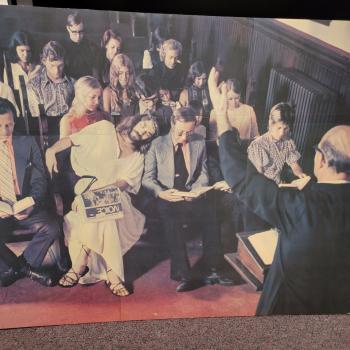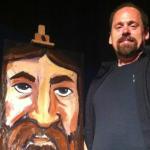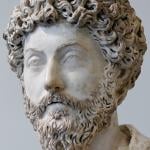Having read the second volume of the Pope’s study of the life of Christ, I was so enthusiastic about it, I asked my friends at Ignatius Press to send me the first volume (and there may be a third one on the birth narratives). So, despite working backwards, this exercise will be worthwhile. In the Foreword to the first volume the Pope both stresses the necessity of historical critical study of the Scriptures, but also of the importance of going beyond it. He is interested in more deeply theological and canonical readings of the Bible and indeed in the traditional fourfold way of reading it as well. One of the more interesting comments he makes in the brief Foreword is this, speaking about what inspiration means when we talk about the Biblical writers—- “The author does not speak as a private, self-contained subject. He speaks in a living community, that is to say, in a living historical movement not created by him, not even by the collective, but which is led forward by a greater power that is at work…. The four senses of Scripture are not individual meanings arrayed side by side, but dimensions of the one word that reaches beyond the moment” (p. xx). I think the first two sentences are especially important. We tend to view inspiration as a private and personal thing and forget the inspired person’s a part of a larger Spirit-led community. And if it is the Spirit who is prompting the speech, then the question of which human speaker is actually doing the verbalizing is less important. This might in part explain why we have so many anonymous documents in the NT. There was no felt need to claim some great human authority as the author, unlike in later Christian times in the second-fourth centuries long after the apostles had died.
In the Introduction which follows the Foreword, we have the interesting argument that Deut. 18.9-15 explains much about John 1, namely that Jesus is the foretold prophet who like Moses will talk to God face to face, and even greater than Moses has seen the face of God and reveals it on earth. The Pope stresses that you cannot understand what Jesus says about the Father without understanding the deep intimacy between the Son and the Father, which implies as much about the Son as the Father. I think he is right about this— Christology as well as theology proper is right at the heart of the Jesus story. Who Jesus is, in relationship to the Father is critical to understanding him and why he spoke and acted as he did, not like a mere prophet, but speaking with the voice of God, having an inherent and direct authority, not a derived authority. Bearing these things in mind, the Pope next turns to his discussion of the baptism of Jesus.
The Pope’s discussion of the genealogies in Mt. 1 and Lk. 3 is helpful and reflects a real wrestling with the problems inherent in them. As he says, they are not intended to establish a precise chronology but are rather schematized to emphasize larger concerns, for example that Jesus is the Davidic messiah, or that Jesus is Son of Man and a new founder of the human race like Adam (p. 10). The former sets Jesus within the history of Israel, the latter within the history of the world. As the Pope goes on to stress, Luke’s synchronisms make clear that he is indicating we are not dealing with a myth here but rather real history and a real historical person. The Pope stresses that while the divine and human realms talked about here (kingdom of God vs. kingdom of Augustus) are compatible, if the human king claims divine status, we have a conflict, a conflict which leads to martyrs, and so the listing of the rulers in Israel, including Herod Antipas and Pontius Pilate are foreshadowings of how John and Jesus’ lives will end— in martyrdom. Strangely the Pope says that Judas the Galilean led an uprising at about the time of Jesus’ birth (p. 12) but in fact this took place in 6 A.D. not in 3-6 B.C. On the other hand, the Pope rightly identifies the Essenes with the Qumran community (p. 13), and makes the plausible case that John the Baptizer was at one point part of this community (p. 14).
A note on the mistakes in this book. In the beginning of this book the Pope makes clear he is not saying these things in these books ex cathedra, that is, in his role of making infallible pronouncements as a Pope, but writes in his own name Joseph Ratzinger, speaking as a scholar and theologian, and he even invites corrections of places he went awry. This is refreshing, and needs to be said, for some Protestants might mistakenly think that just because someone is the Pope, we should evaluate everything he says as if it were meant as an inerrant pronouncement directly from God. This is not so.
Because of the lack of genuine prophetic voice in Israel, when John emerged he created quite a sensation, and not for this reason alone, but also because he was offering a baptism for remission of sins (notice, not a sacrifice for remission of sins), a one time only ritual signally a real turning around, a change in a life’s direction. As the Pope says on p. 15, baptism symbolizes death, the chaos waters flooding over us, being drowned. But baptism in a river would also symbolize life, as the Nile, the Euphrates etc. Thus the Pope wants to suggest that baptism is a symbol of both death and resurrection– rebirth, new life. I am not so sure about the latter part. The past is repented of so that it can be left behind, and washed off, so to speak, but nothing in the baptism of John, or later Christian baptism necessarily suggests resurrection. One gets baptism in order to then go and walk in newness of life, but that is subsequent to baptism.
The interpretation of the baptism of Jesus by John is interesting (pp. 15-17) and should be read carefully. Jesus submits to baptism with the words ‘let it be so now’… and the Pope interprets this to mean that Jesus, for the time being, is identifying with fallen humanity, and obeying God’s will that he must lay the burden of human sin on himself, and then go the way of the cross, paying for those sins. He also makes the interesting suggestion that the ‘this is my Beloved Son’ pronouncement anticipates God’s verdict at the resurrection of Jesus, which, says the Pope, is why Jesus comes to call his death a baptism— because thereafter God will pronounce Jesus the risen Lord. This is interesting, but not something the text of Mark or Matthew suggests directly. On p. 19 the Pope discusses the Eastern orthodox tradition which suggests that baptism is a symbol of Jesus going down into the land of the dead, and rising thereafter. The Pope himself makes the connection with the Jonah story— Jesus like Jonah is submersed in the water in order that all other may be rescued from being drowned (in the judgment on sin, presumably). All this theologizing in the Catholic and Orthodox traditions is of course in part because so much came to be vested and invested in the sacrament of baptism, which came to be seen as a very means of salvation, such that if a child was dying in infancy you needed to race out and baptize them so they could be saved. Of this, the NT says nothing, and it can be doubted whether this even comports with what the NT does say (see my little book Troubled Waters ). Paul for example says in 1 Cor. 1— ‘I thank God I didn’t baptize more of you’ but he could never have said ‘I thank God I didn’t save more of you’. It is a mistake to make baptism a or the means of salvation, but at the same time one doesn’t want to make the mistake the Quakers and Salvation Army sometimes makes at the other end of the spectrum— namely assuming baptism is not required or necessary. It is, if one wants to obey Christ (see Mt. 28).
Thus baptism is seen by the Pope as Christ symbolically going down into the underworld, binding the strong man, setting free his captives, so they can rise to newness of life. The Pope not surprisingly, rightly asks— does all this theologizing take us too far away from the Bible? His answer is to point to the Lamb of God saying in John 1. Interpreting the saying with the help of the work of J. Jeremias’ article in TDNT I p. 339 he sees allusions here to Is. 52-53 and he makes something of Jeremias’ observation that the word translated lamb could also mean servant. Israel’s election was not for itself alone, but so it would become the light of the vehicle for the world’s salvation. Like the Passover lamb’s blood over the door, which averted the angel of death, so Jesus’ death averts judgment on the sinner, the wages of sin being death. In other words, the reference to Jesus as Lamb of God (p. 22) interprets his baptism in terms of his coming death. This may well be correct.
The sky cracks, and a voice speaks to Jesus from above. The opening of the heavens is taken in a broad sense by the Pope, namely that heaven is always open, and Jesus is always hearing from his Father, beginning at this juncture. Not surprisingly, the Pope comments as did many church fathers about the Trinitarian nature of the scene— the Son is baptized, the Spirit descends, the Father speaks. He understandably cautions against trying to psychologize the scene here, as some novelistic biographies of Jesus have done. But there is something missing in the exposition of the baptism. Why exactly did a person with a divine nature need to have the Spirit of God come on him empowering him for his ministry? And why exactly is it that only after the Spirit came upon Jesus that he heard clearly the voice, the naming, the call of God on him? I would suggest that it is because Jesus the Son of Man would go forth from his baptism and rely not on his divine nature to get him through life, but on the same two resources we humans all have to get by, and get beyond our temptations— the Spirit of God and the Word of God.aHa

















